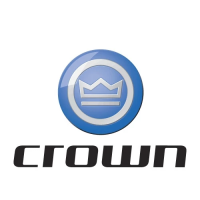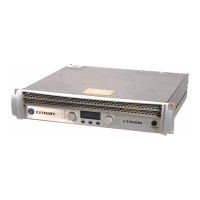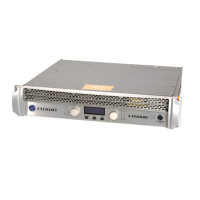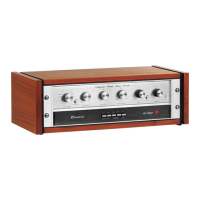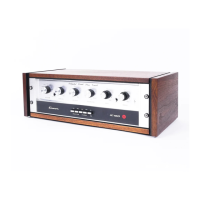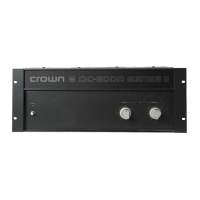Operation Manual
I-Tech HD Series Power Ampliers
page 12
I-Tech HD Series Power Ampliers
Operation Manual
page 13
H. MAC Address
This specific amplifier’s network identifier that is burned into its
firmware.
I. Preset Indicator
LED flashes to signal the number of the current preset if active.
LED is green if the preset values have not been changed once
loaded. LED is yellow if the preset values have been changed
since they were loaded.
J. Reset Button
To restore factory default settings: Press the Reset Button with a
thin, non-conductive object, then turn on amplifier power, and
continue to hold the reset button until the Preset light comes
on green (approximately 16 seconds)..
K. Data Indicator
Flashes yellow only when the amplifier is polled for data, or is
polled to see whether it is online.
DIGITAL INPUTS SECTION
L. AES/EBU Digital Input
This 3-pin female XLR connector accepts a dig ital signal in the
AES/EBU format.
3 Operation
Figure 3.1 Front Panel Controls and Indicators
3.4 Front Panel Controls and Indicators
Many of these functions can be disabled using
Blackout Mode (a selection in the Advanced
Menu, Section 4.2.3).
A. Cooling Vents
Front-to-rear forced airflow through foam dust filter
B. LCD Control Screen
Integrated LCD with white backlight, controls
ampli fier setup and operation.
The LCD Control Screen and its controls let the user
adjust the amplifier’s attenuation and muting,
con figure the amp, set up and view error monitoring
(such as temperature and load supervision), and
recall DSP presets. The presets allow the user to
quickly reconfigure the amp for various applica tions.
C. Power Switch
Push-on/push-off switch glows green when AC
power is present at the power cord and the amplifier
circuit breaker is in the “on” position.
D. USB 2.0 Connector
Accepts a USB drive to transfer presets from the
drive to the amplifier DSP, and vice versa.
E. Fault Indicator
Red LED, one per channel, flashes when the
ampli fier output channel has stopped operating.
Usually this means that the amplifier must be
serviced.
F. Thermal Indicator
Red LED, one per channel, illuminates when the
channel has shut down due to thermal stress or
overload.
G. Clip Indicator
Red LED, one per channel, illuminates when the
channel’s output signal reaches the onset of audible
clipping. The Clip Indicator also will illuminate
dur ing Thermal Level Control (TLC) limiting. The
Clip Indicator can be turned of during Blackout
mode.
H. Level Controls (Encoders)
Speed-sensitive, 0.5 dB steps, range 0 to –100 dB.
These two knobs affect the Channel-1 and
Channel-2 output levels. They also select Menu
items and adjust parameter values that are displayed
on the LCD control screen.
I. Menu/Exit Button
“Menu” enters the main menu. “Exit” leaves the
menu.
J. Prev Button
Selects the previous item in the menu.
K. Next Button
Selects the next item in the menu.
L. Signal Indicators
These can be disabled during Blackout mode. Three
green LEDS per channel indicate the ampli fier’s input
and output signal levels. From top to bot tom the
LEDs are
–10 dB: amplifier output is 10 dB below clipping.
–20 dB: amplifier output is 20 dB below clipping.
Signal: selected input signal is above –40 dBu.
M. Ready Indicator
Green LED, one per channel, illuminates when the
channel is initialized and ready to produce audio
out put. Indicator is off when the channel is set to
standby mode via System Architect or in Blackout
mode.
N. Power Indicator
Blue LED indicates amplifier has been turned on and
AC power is available. The LED will flash when the AC
line voltage is 15% above or below the nominal rated
range. This indicator can be turned off in Blackout
mode.
O. Data Indicator
Yellow LED indicates network data activity. Data
indicator flashes only when the amplifier is polled for
data, or is polled to see whether it is online. This
indicator can be turned off in Blackout mode.
P Bridge Mode Indicator
Yellow LED illuminates when the amplifier is set to
Bridge-Mono mode.
3 Operation
Figure 3.2 Back Panel Controls and Connectors
3.5 Back Panel Controls, Indica tors
and Connectors
A. Fans
Provide front-to-back forced airflow for cooling.
ANALOG INPUTS SECTION
B. Balanced Analog XLR Inputs
A 3-pin female XLR connector for each channel.
C. Balanced Analog XLR Loop-Through
Outputs
Two 3-pin male XLR output connectors are pro vided
(one per channel). The signal at these connectors is
paralleled with the input signal for feeding the input
signal to other amplifiers.
OUTPUTS SECTION
D. 4-Pole Speakon
®
Output Connectors
Two high-current, 50A Neutrik
®
Speakon
®
NL4MLP
(mates with NL4FC and NL4), one per channel.
Class 2 output wiring required.
These two connectors accept 2-pole or 4-pole
Speakon
®
connectors. See Figures 2.5 through
2.10 and Tables 1, 2 and 3 for connector wiring.
The top Speakon
®
connector is wired for both
channels so it can be used for bridge-mono
wiring or for stereo wiring of two speakers to a
single Speakon
®
connector.
E. Binding Post Output Jacks
One pair per channel of high-current, 60A color-
coded binding posts. Accepts banana plugs,
wire or spade lugs.
F. Power Cord Connector
Standard 20 amp IEC inlet. Voltage range is
indicated above IEC inlet.
G. Reset Switch/Circuit Breaker
If the current draw of the amplifier exceeds safe
limits, this breaker automatically disconnects
the power supply from the AC mains. The switch
resets the circuit breaker.
M AES/EBU Digital Loop-through Output
Male XLR active/re-clocked AES/EBU digital loop-through.
The signal at this connector duplicates the digital input
signal for feeding the input signal to other amplifiers.
It is not recommended to loop through more than four
amplifiers. If larger distribution of AES is needed, the use of
an AES distribution ampli fier is recommended.
NETWORKING SECTION
N. Link/Act Indicator
Shows net work activity.The LINK ACT LED illuminates when
the network port is connected and flashes when network
activity is detected.
O. Network Connector
This EtherCon
®
Ethernet connector is for networking.
Warning: Only connect to networks that remain inside the
building.
P. Cond Indicator
Turns on if the amplifier is set to be the CobraNet conductor.
The CobraNet conductor is a CobraNet node that provides
the master timing clock for the CobraNet digital audio
transport network.
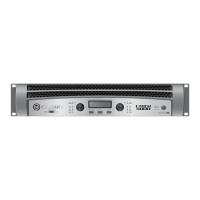
